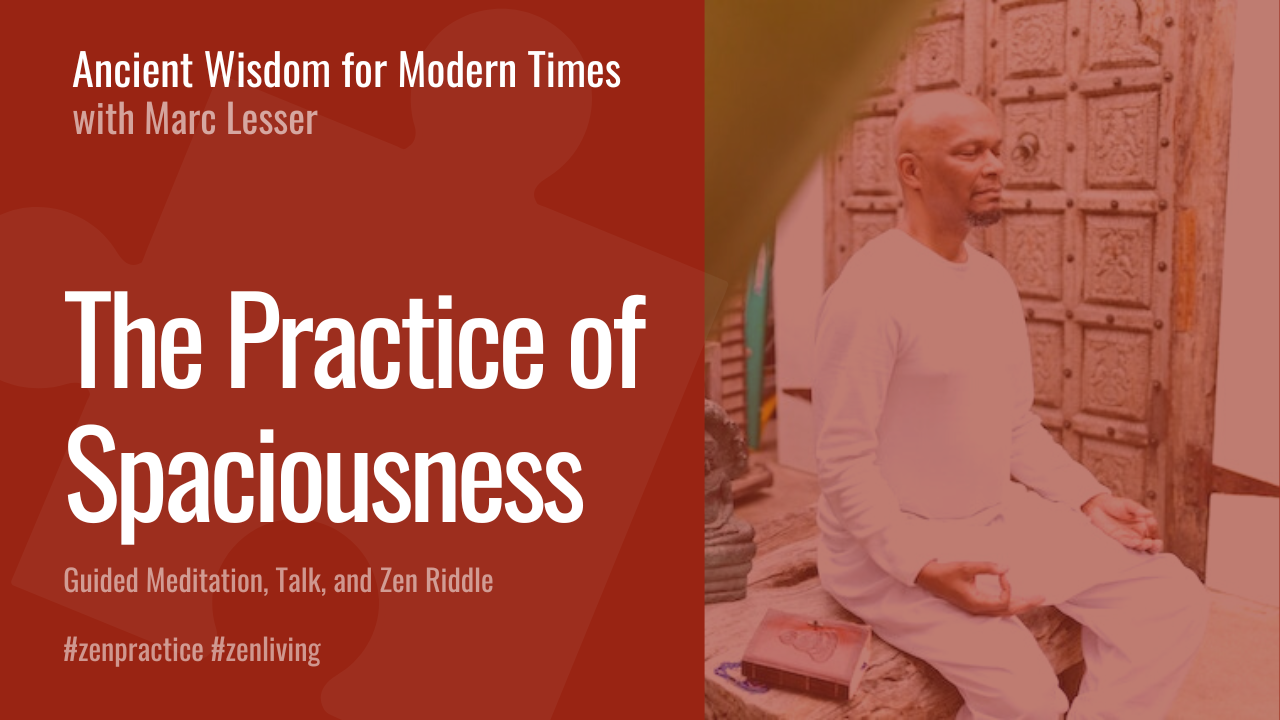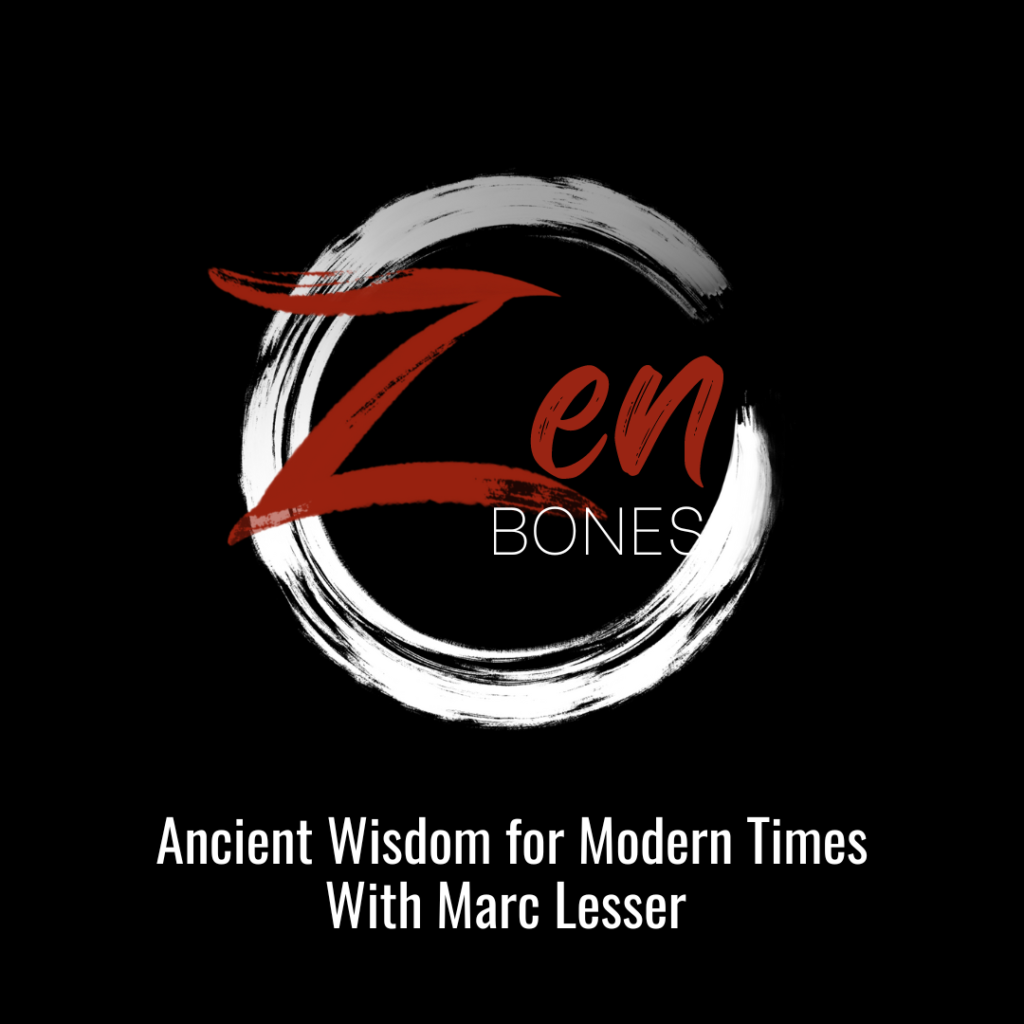In this Practice episode, Marc offers a short meditation on finding more spaciousness as a way of being. He also gives a short talk on ways to be less busy, and more open, engaged, and spacious through the practice of setting an intention, engaging in ongoing learning, and intentionally practicing spaciousness and accountability.
Today’s Zen puzzler is a story about spaciousness and “finding the one who is not busy.”
EPISODE TRANSCRIPT
Marc Lesser: Welcome to Zen Bones: Ancient Wisdom for Modern Times. This is Marc Lesser. Why Zen Bones? Our world is in crisis and ever-shifting, and now more than ever, more wisdom, clarity, and courage are essential, especially in the world of work, business, and leadership.
In today’s episode, we do a short, guided meditation on the topic of finding more spaciousness as a way of being, being less busy and more open, curious, engaged and spacious. I then do a short talk on this topic of spaciousness, of finding the one who is not busy. I outline this as a practice from setting an intention to practicing, to holding yourself accountable and ongoing learning. Today’s Zen puzzler is a story about spaciousness. It’s a story called Finding the One Who Is Not Busy. I hope you enjoy this episode.
Let’s do some sitting practice together.
[bell chime]
So pausing, stopping, and just in the transition from whatever you were doing to stopping, bringing attention to being here, noticing the body, making conscious choices about how to be, whether you’re sitting, or walking, or driving, or bringing attention to how you are in your body right now. Making conscious choices about how you are placing your hands, your feet, opening the chest and shoulders, and allowing, allowing the body to be a sense of at rest and spaciousness even if you are moving.
Mindfulness practice and awareness practice doesn’t always mean to slow down or to stop, but right now we’re practicing if we can, practicing slowing down, practicing, pausing, and cultivating a sense of curiosity, warmhearted curiosity, and a sense as well of spaciousness. I think this is an underutilized, undervalued practice, noticing the space around you, the space in between you and objects and also, cultivating open and spacious way of being.
So much of our stress and anxiety is usually the opposite of spacious. It’s usually, think of it as a sense of a lack of space or tightness. This practice of cultivating a quality mindset of openness and spaciousness is really useful, and important to be able to cultivate it here when we’re– There’s no pressure at all here, just breathing, being, noticing, but practicing now so that we can bring this same quality into the challenges of our lives and work and relationships, conversations.
Right now, we’re bringing attention to the body and bringing attention to the breath and feeling, accessing that feeling of spaciousness in the body, spaciousness with each breath, just simply breathing in and breathing out with nothing really to measure or accomplish. Can you feel it? Can you feel that sense of openness and spaciousness right now?
Yes, this sense, this practice of that our minds includes everything, right? Nothing can trouble us right now. You yourself make the waves in the mind. If we leave the mind just as it is, it will become more settled and more calm. This is the, call it spaciousness, or we can call it big mind, practice of big mind, where everything is included is the essence of mind. This is the experience of, whether we call it spaciousness or sacredness or yes. Waves come and go, but our minds are open like clear water. Whether it’s waves or whether it’s water, this is spacious. This is a big mind and keeping it simple. Keeping it simple, simply breathing in, breathing out. Here, nothing to accomplish.
I’m going to transition. You are welcome to continue sitting, or you can stay and join me as I am going to ring the bell to end this period of sitting and do a short talk on spaciousness and finding the one who’s not busy.
[bell chime]
[music]
The practice of spaciousness within a busy day or finding the one who’s not busy is a really important, simple, useful, lifetime practice again and again. Let’s start with this story that you may or may not be familiar with, but it’s the question that I’m most asked by Google engineers is what is the least amount I can meditate and have it make a difference? My answer to this question is one breath.
Experiment with being aware and appreciating one breath each day and see how this influences your work and your life. This is verily practicing with a sense of spaciousness by being aware of the breath. One aware mindful breath can add a mindset and an approach of spaciousness that you can then remember, cultivate, bring into our busy days, into our busy lives.
Again, I don’t like the word busy so much. I think it’s way overused and it’s become almost a religion of busyness. We wear it as a badge of honor. “How are you doing?” “I’m really busy.” What if instead of being busy, we were engaged? We were even spacious. “Oh, how are you?” “I’m feeling really spacious today. I’m getting a lot done. I’m being really effective. I’m having great conversations. My writing is going well.” Yes, it doesn’t have to be busy. It’s a very different sense. It’s so common. It’s almost the default mode in our culture, the busier, the better.
It can be challenging to stop, to relax, to take time for yourself, to take some well-being time, or family time. Often, I’ve noticed that transitions can be challenging, especially if we are using a lot of our energy and activity and then we try to transition to be with our families, or children, or our partners, or even just some time to relax. I think it’s important to have- -the ability to make these transitions. More we are aware of our energy, the more we can practice with spaciousness and being aware of our energy right in the middle of our engaged days. The transition can be much simpler and easier. It’s not such a great big leap.
Again, there’s another reason why I think it’s so important, this practice of spaciousness is. It’s not only stepping outside of activity, but shifting our approach, shifting the way that we work with our minds and bodies. It’s a core part of a mindfulness practice, being able to bring and cultivate a sense of spaciousness right in the midst of activity.
I love watching great athletes like a great quarterback who is relaxed and spacious even as they are about to get clobbered by the opposing team. It’s essential that they stay spacious, focused, and make decisions about throwing the ball, not throwing the ball, handing off the ball. Again, I think this is true of whether it’s tennis players, or basketball players, or even golfers, spaciousness.
One way to think about spaciousness as a practice is to begin with the intention, to have the intention of bringing and cultivating spaciousness into our daily lives. It begins with the aspiration, how can I find a sense of greater ease in the midst of my work, in the midst of shifting from one activity to another, in the middle of having difficult conversations or driving or being in meetings? It may seem impossible, but it’s about setting the intention even if it feels hard.
I was just with my three-year-old grandson recently in Missoula, Montana. We were walking together and it was really cold. It was like zero degrees or even maybe a few degrees below zero. I was concerned about him and I said, “Are you warm enough?” He looked at me, and said, “I’m not afraid of the cold.” I loved that attitude. I think it’s that same attitude about cultivating a sense of spaciousness right in the midst of challenging busy days. I sometimes think, “I’m not afraid of being busy. I’m not afraid of being really engaged and working hard.” I think it starts with the courage and intention to practice.
Then I think in order to be able to be successful, competent at this practice of spaciousness, we need to have some practices. I think it starts with a daily meditation practice, practicing spaciousness where we can, step outside of the activity of our day. Great quarterbacks, great athletes, they spend a lot of time practicing. It’s not easy to stay calm and spacious right in the middle of when there’s a tremendous amount of activity and people coming at you.
You can start by this experiment that I mentioned earlier about Google engineers. Start maybe by taking one conscious breath a day but even better is to spend 5 minutes, 10 minutes, 20 minutes, a half hour, whatever works for you though. It’s really more about consistency. There is something about practicing spaciousness outside of the game of work and life makes it much, much more possible to bring that sense of spaciousness into our activity.
One is setting the intention, having practices, and then it’s also I think accountability, being able to check in. “How’s it going? How’s it going? How did I do in my practice of meditation today? How did I do in spaciousness? Were there some moments when I was feeling spacious? Were there moments when it was a lot more challenging, maybe I lost it, I felt some anxiety and tension, and it was hard but great,” so just checking in, a sense of holding ourselves accountable, and then ongoing learning.
This is a learning process, learning from, “How am I doing with my intention, my practice, and with this process of noticing, remembering to check in. Then, beginning again, starting fresh each day, perhaps during each transition, bringing back that intention of cultivating a sense of spaciousness.
I want to read a short poem about spaciousness by Zen teacher Ryōkan, who lived in Japan from the 1700s to the early 1800s, a beautiful teacher, someone who lived a life of spaciousness in the midst of activity. He ended up becoming a renowned poet and calligrapher who had this radically spacious childlike way of being in the world. He says, “What was right yesterday is wrong today. How do you know it was wrong yesterday? There is no right or wrong. There is no predicting gain or loss. Unable to change their tune, those who are foolish glue down bridges of a lute. Those who are wise go to the source but keep wandering about for long. Only when you are neither wise nor foolish can you be called one who has attained the way.”
Those who are wise go to the source. Here I think he’s saying wisdom is about finding our source of spaciousness and [inaudible 00:16:45]. Only when you are neither wise nor foolish, so going beyond our usual judgments about good and bad, yes and no, right and wrong, attaining the way. I think this attaining the way is the way of living a life where each moment has some kernel of spaciousness, some sense of a human spiritual practice.
This particular translation of this poem is by Kaz Tanahashi, my good friend, from a book called Sky Above, Great Wind. It’s a book about Ryōkan’s poetry. Please do aspire and practice to bring more spaciousness, engaged, warm-hearted, curious spaciousness into your day-to-day life.
[music]
Welcome to the Zen Bones puzzler, where I will regularly be presenting a story or a Zen koan or a poem, something to contemplate, to think about, a story that has purpose. It’s about developing greater insight and reflection, not so much for a solution, but as a way to support your practice, a kind of meditation in daily life.
Today’s Zen puzzler is a story about spaciousness. This is a story about two Zen teachers that lived in the 7th Century China. This is actually a traditional Zen koan. Some of these Zen puzzlers come from collections of Zen koans, often from the 5th, 6th, and 7th century, and sometimes I’ve been playing with more modern ones. This one is an ancient koan, but it is so, so relevant, and I think important in today’s world.
It’s two teachers who live in a monastic setting. One teacher is sweeping some stone steps inside the temple with a wooden broom. Another teacher comes up to him and looks at him and says, “Too busy.” Essentially, he’s saying, “Why are you sweeping when you should be meditating or undertaking some kind of contemplative practice?” In this story, the first teacher holds up the broom and looks at the other, and says, “You should know there is one who is not too busy.” You should know there is one who is not too busy.
Though we often associate- -busyness with activity and speed and lack of busyness with stopping or slowing down, this is not always the case. This is an important practice of being able to find our own spaciousness, our own centeredness, our own real connection with ourselves right in the midst of activity, whether we’re sweeping, or working, or writing, in a meeting, in a call. Whatever our activity is, this particular Zen story, this Zen koan, Zen puzzler is inspiration and opening the gate to finding the one who is not too busy.
Not being busy does not mean stopping, not even slowing down, stepping out of the– We can find spaciousness without having to stop, without having to step out of our activity. This is an opportunity to learn, to adjust, to find our composure right in the midst of the activity and intensity of our lives. Just like this talk that I just gave, it’s about the practice of spaciousness, but not even– It’s a radical spaciousness because it’s spaciousness, connection, heartfelt, right in the midst of whatever we’re doing, whatever it is.
Again, I think it does take intention, some aspiration, some practice, some ongoing accountability. You might experiment with this particular line, finding the one who is not busy. You might journal about it, maybe write it down as a note to yourself to keep near you on your desk or in your car, wherever you spend time. What does that mean, finding the one who is not busy?
It doesn’t have to be some answer. It’s more like the way these koans are used in Soto Zen practice. It’s not about finding an answer. It’s more about using these words, using these stories as ongoing reminders, questions, inspiration, a way to imagine being able to, again and again, finding the one who’s not busy, finding the one who’s not busy. Thank you very much.
[music]
Listen in each week for interviews, teachings, and guided meditations. You’ll receive supportive tools for creating more meaningful work and mindfulness practices to develop yourself, to influence your organization, and to help change the world. Thank you for listening.
[00:23:16] [END OF AUDIO]









